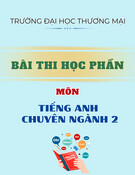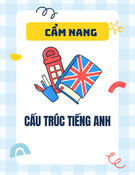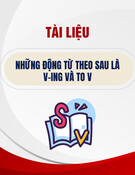
The coast of the State of Maine is one of the most irregular in the world. A straight line running from the south-
ernmost coastal city to the northernmost coastal city would measure about 225 miles. If you followed the coast-
line between these points, you would travel more than ten times as far. This irregularity is the result of what is called
a drowned coastline. The term comes from the glacial activity of the Ice Age. At that time, the whole area that is
now Maine was part of a mountain range that towered above the sea. As the glacier descended, however, it expended
enormous force on those mountains, and they sank into the sea.
As the mountains sank, ocean water charged over the lowest parts of the remaining land, forming a series
of twisting inlets and lagoons of contorted grottos and nooks. The highest parts of the former mountain range,
nearest the shore, remained as islands. Mt. Desert Island was one of the most famous of all the islands left behind
by the glacier. Marine fossils found here were 225 feet above sea level indicating the level of the shoreline prior to
the glacier.
The 2,500 mile long rocky and jagged coastline of Maine keeps watch over nearly 2,000 islands. Many of these
islands are tiny and uninhabited, but many are home to thriving communities. Mt. Desert Island is one of the
largest, most beautiful of the Maine coast islands. Measuring 16 miles by 12 miles, Mt. Desert was very nearly
formed as two distinct islands. It is split almost in half by Somes Sound, a very deep and very narrow stretch of
water seven miles long.
For years, Mt. Desert Island, particularly its major settlement, Bar Harbor, afforded summer homes for the
wealthy. Recently though, Bar Harbor has become a burgeoning arts community as well. But, the best part of the
island is the unspoiled forest land known as Acadia National Park. Since the island sits on the boundary line between
the temperate and subarctic zones, the island supports the flora and fauna of both zones as well as beach, inland,
and alpine plants. It also lies in a major bird migration lane and is a resting spot for many birds.
The establishment of Acadia National Park in 1916 means that this natural monument will be preserved and
that it will be available to all people, not just the wealthy. Visitors to Acadia may receive nature instruction from
the park naturalists as well as enjoy camping, hiking, cycling, and boating. Or they may choose to spend time at
the archeological museum learning about the Stone Age inhabitants of the island.
The best view on Mt. Desert Island is from the top of Cadillac Mountain. This mountain rises 1,532 feet,
making it the highest mountain on the Atlantic seaboard. From the summit, you can gaze back toward the main-
land or out over the Atlantic Ocean and contemplate the beauty created by a retreating glacier.
–POSTTEST–
163

37. Which of the following lists of topics best
outlines the information in the selection?
a. — Ice-Age glacial activity
— The Islands of Casco Bay
— Formation of Cadillac Mountain
— Summer residents of Mt. Desert Island
b. — Formation of a drowned coastline
— The topography of Mt. Desert Island
— The environment of Mt. Desert Island
— Tourist attractions on Mt. Desert Island
c. — Mapping the Maine coastline
— The arts community at Bar Harbor
— History of the National Park system
— Climbing Cadillac Mountain
d. — The effect of glaciers on small islands
— Stone-Age dwellers on Mt. Desert Island
— The importance of biodiversity
— Hiking in Acadia National Park
38. Which of the following statements best expresses
the main idea of paragraph 4 of the selection?
a. The wealthy residents of Mt. Desert Island
selfishly kept it to themselves.
b. Acadia National Park is one of the smallest of
the national parks.
c. On Mt. Desert Island, there is great tension
between the year-round residents and the
summer tourists.
d. Due to its location and environment, Mt.
Desert Island supports an incredibly diverse
animal and plant life.
39.
According to the selection, the large number of small
islands along the coast of Maine are the result of
a. glaciers forcing a mountain range into the sea.
b. Maine’s location between the temperate and
subarctic zones.
c. the irregularity of the Maine coast.
d. the need for summer communities for wealthy
tourists and artists.
40. The content of paragraph 5 indicates that the
writer believes that
a. the continued existence of national parks is
threatened by budget cuts.
b. the best way to preserve the environment on
Mt. Desert Island is to limit the number of
visitors.
c. national parks allow large numbers of people
to visit and learn about interesting wilderness
areas.
d. Mt. Desert Island is the most interesting
tourist attraction in Maine.
41. According to the selection, the coast of Maine is
a. 2,500 miles long.
b. 3,500 miles long.
c. 225 miles long.
d. 235 miles long.
42. What is the meaning of the underlined phrase
flora and fauna in paragraph 4 of this passage?
a. insects and plants
b. plants and animals
c. deer and coyote
d. birds and beaches
–POSTTEST–
164

The immune system is equal in complexity to the combined intricacies of the brain and nervous system. The suc-
cess of the immune system in defending the body relies on a dynamic regulatory communications network con-
sisting of millions and millions of cells. Organized into sets and subsets, these cells pass information back and forth
like clouds of bees swarming around a hive. The result is a sensitive system of checks and balances that produces
an immune response that is prompt, appropriate, effective, and self-limiting.
At the heart of the immune system is the ability to distinguish between self and nonself. When immune
defenders encounter cells or organisms carrying foreign or nonself molecules, the immune troops move quickly
to eliminate the intruders. Virtually every body cell carries distinctive molecules that identify it as self. The
body’s immune defenses do not normally attack tissues that carry a self-marker. Rather, immune cells and other
body cells coexist peaceably in a state known as self-tolerance. When a normally functioning immune system attacks
a nonself molecule, the system has the ability to “remember” the specifics of the foreign body. Upon subsequent
encounters with the same species of molecules, the immune system reacts accordingly. With the possible excep-
tion of antibodies passed during lactation, this so called immune system memory is not inherited. Despite the
occurrence of a virus in your family, your immune system must “learn” from experience with the many millions
of distinctive nonself molecules in the sea of microbes in which we live. Learning entails producing the appro-
priate molecules and cells to match up with and counteract each nonself invader.
Any substance capable of triggering an immune response is called an antigen. Antigens are not to be con-
fused with allergens, which are most often harmless substances (such as ragweed pollen or cat hair) that provoke
the immune system to set off the inappropriate and harmful response known as allergy. An antigen can be a virus,
a bacterium, a fungus, a parasite, or even a portion or product of one of these organisms. Tissues or cells from
another individual (except an identical twin, whose cells carry identical self-markers) also act as antigens; because
the immune system recognizes transplanted tissues as foreign, it rejects them. The body will even reject nourish-
ing proteins unless they are first broken down by the digestive system into their primary, nonantigenic building
blocks. An antigen announces its foreignness by means of intricate and characteristic shapes called epitopes, which
protrude from its surface. Most antigens, even the simplest microbes, carry several different kinds of epitopes on
their surface; some may even carry several hundred. Some epitopes will be more effective than others at stimu-
lating an immune response. Only in abnormal situations does the immune system wrongly identify self as non-
self and execute a misdirected immune attack. The result can be a so-called autoimmune disease such as
rheumatoid arthritis or systemic lupus erythematosis. The painful side effects of these diseases are caused by a per-
son’s immune system actually attacking itself.
–POSTTEST–
165
43. What is the analogy used to describe the
communications network among the cells in
the immune system?
a. the immune system’s memory
b. immune troops eliminating intruders
c. bees swarming around a hive
d. a sea of microbes
44. The immune cells and other cells in the body
coexist peaceably in a state known as
a. equilibrium.
b. self-tolerance.
c. harmony.
d. tolerance.

45. What is the specific term for the substance
capable of triggering an inappropriate or
harmful immune response to a harmless
substance such as ragweed pollen?
a. antigen
b. microbe
c. allergen
d. autoimmune disease
46. How do the cells in the immune system
recognize an antigen as “foreign” or “nonself?”
a. through an allergic response
b. through blood type
c. through fine hairs protruding from the
antigen surface
d. through characteristic shapes on the antigen
surface
47. After you have had the chicken pox, your
immune system will be able to do all of the
following EXCEPT
a. prevent your offspring from infection by the
chicken pox virus.
b. distinguish between your body cells and that
of the chicken pox virus.
c. “remember” previous experiences with the
chicken pox virus.
d. match up and counteract nonself molecules in
the form of the chicken pox virus.
48. Which of the following best expresses the main
idea of this passage?
a. An antigen is any substance that triggers an
immune response.
b. The basic function of the immune system is to
distinguish between self and nonself.
c. One of the immune system’s primary
functions is the allergic response.
d. The human body presents an opportune
habitat for microbes.
49. Why would tissue transplanted from father to
daughter have a greater risk of being detected as
foreign than a tissue transplanted between
identical twins?
a. The age of the twins’ tissue would be the same
and therefore less likely to be rejected.
b. The identical twin’s tissue would carry the
same self-markers and would therefore be less
likely to be rejected.
c. The difference in the sex of the father and
daughter would cause the tissue to be rejected
by the daughter’s immune system.
d. The twins’ immune systems would “remem-
ber” the same encounters with childhood
illnesses.
50. What is the meaning of the underlined word
intricacies as it is used in the first sentence of the
passage?
a. elaborate interconnections
b. confusion of pathways
c. inherent perplexity
d. comprehensive coverage
–POSTTEST–
166

Answer Key
–POSTTEST–
167
1. c. Lesson 3
2. b. Lesson 1
3. b. Lesson 18
4. c. Lesson 2
5. a. Lesson 8
6. c. Lesson 14
7. d. Lesson 1
8. a. Lesson 1
9. b. Lesson 2
10. c. Lesson 8
11. c. Lesson 4
12. d. Lesson 12
13. c. Lesson 3
14. d. Lesson 11
15. a. Lesson 4
16. b. Lesson 3
17. c. Lesson 12
18. b. Lesson 13
19. a. Lesson 11
20. d. Lesson 12
21. a. Lesson 8
22. d. Lesson 16
23. d. Lesson 6
24. b. Lesson 11
25. b. Lesson 16
26. d. Lesson 17
27. a. Lesson 1
28. a. Lesson 16
29. c. Lesson 3
30. b. Lesson 3
31. c. Lesson 6
32. d. Lesson 16
33. d. Lesson 13
34. c. Lesson 16
35. c. Lesson 4
36. a. Lesson 3
37. b. Lesson 1
38. d. Lesson 2
39. a. Lesson 9
40. c. Lesson 4
41. a. Lesson 1
42. b. Lesson 3
43. c. Lesson 8
44. b. Lesson 1
45. c. Lesson 3
46. d. Lesson 9
47. a. Lesson 6
48. b. Lesson 2
49. b. Lesson 9
50. a. Lesson 3


![Đề cương học phần Ứng dụng công nghệ thông tin trong giảng dạy ngoại ngữ (Application of Information Technology in Language Teaching) [Mới nhất]](https://cdn.tailieu.vn/images/document/thumbnail/2025/20250212/tuetuebinhan666/135x160/881739332468.jpg)









![Bài tập thì hiện tại hoàn thành [kèm đáp án chi tiết]](https://cdn.tailieu.vn/images/document/thumbnail/2025/20251106/thuthao27062004/135x160/41601762420911.jpg)






![Tài liệu ôn tập Ngữ pháp tiếng Anh [chuẩn/mới nhất/tổng hợp]](https://cdn.tailieu.vn/images/document/thumbnail/2025/20250821/vuongdinhlinh1412@gmail.com/135x160/933_tai-lieu-on-tap-ngu-phap-tieng-anh.jpg)




